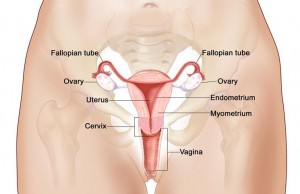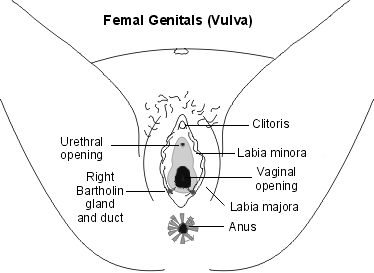 Made to perform several different functions, the female reproductive system makes the female egg cells which are needed for reproduction, which are called the oocytes or ova. It also transports the ova to where it is fertilized. The fertilization of an egg by a sperm, or conception, usually happens within the fallopian tubes. Once the egg is fertilized, the next step is for it to implant into the uterine walls, which is the start of the first stages of pregnancy. If the implantation and/or the fertilization don’t occur, the system will then menstruate, which is the when the uterine lining is shed monthly. Plus, the reproductive system of the female makes female sex hormones which maintain the reproductive cycle.
Made to perform several different functions, the female reproductive system makes the female egg cells which are needed for reproduction, which are called the oocytes or ova. It also transports the ova to where it is fertilized. The fertilization of an egg by a sperm, or conception, usually happens within the fallopian tubes. Once the egg is fertilized, the next step is for it to implant into the uterine walls, which is the start of the first stages of pregnancy. If the implantation and/or the fertilization don’t occur, the system will then menstruate, which is the when the uterine lining is shed monthly. Plus, the reproductive system of the female makes female sex hormones which maintain the reproductive cycle.
Parts of Female Reproductive System and Their Function
 The human female, unlike the male, has a reproductive system which is found completely in the pelvis, which is the lowest part of the abdomen, as you can see in the above female reproductive system diagram.
The human female, unlike the male, has a reproductive system which is found completely in the pelvis, which is the lowest part of the abdomen, as you can see in the above female reproductive system diagram.
There are several female body parts both inside and out which make up the anatomy of the female reproductive system. The major structures that make up the external female reproductive system include the following:
|
Internal Female Reproductive System Structure |
Description |
|
Labia majora
|
These enclose and protect the other reproductive organs that are eternal. The literal translation is large lips, and the labia majora are fleshy and fairly large, and can be compared to the scrotum in males. The labia majora has oil and sweat secreting glands. They are covered in hair after puberty. |
|
Labia minora
|
The literal translation is small lips, and the labia minora can be up to two inches wide or rather small. They are found just inside the labia majora, and surround the openings for the vagina (the canal which connects the lower section of the uterus to the outside of the body) and urethra (the tube which urine travels from the bladder to the outside of the body). |
|
Bartholin’s glands |
These are glands found next to the vaginal opening and make a mucus or fluid secretion. |
|
Clitoris |
The labia minora meet at the clitoris, which is a sensitive and small protrusion which can be compared to the penis in males. It is covered by a flap of skin that is known as the prepuce, much like the foreskin at the tip of the penis. The clitoris, like the penis, is quite sensitive to stimulation and can get erect. |
The female internal reproductive organs are:
|
Internal Female Reproductive System Structure |
Description |
|
Vagina |
This is the canal which joins the cervix (lower section of the uterus) to the outside of the body. It is known as the birth canal as well. |
|
Uterus or womb |
This is the pear-shaped, hollow organ which is where a fetus develops. It is divided into two sections – the cervix, or lower section which opens into the vagina, and the main body of the uterus, which is known as the corpus. This can expand easily to hold a baby that is developing. A channel going through the cervix lets sperm enter and menstrual blood exit. |
|
Ovaries |
These are oval-shaped, small glands which are found on both sides of the uterus. They make hormones and eggs. |
|
Fallopian tubes |
They are narrow tubes which are attached to the upper section of the uterus. They act as tunnels for the egg cells or ova so that they can travel from the ovaries to the uterus. Conception, fertilization of an egg by sperm, usually happens in the fallopian tubes. The egg which is fertilized moves then to the uterus, implanting to the lining of the uterine wall. |
For a clear view of female reproductive system diagram, you can refer to:
http://kidshealth.org/teen/interactive/female_it.html
Problems with the Female Reproductive System
1. Vulvovaginitis
An inflammation of the vagina and vulva which could be caused by substances that are irritating like soaps, or poor personal hygiene. Symptoms include itching and redness in the vulvar and vaginal areas and sometimes vaginal discharge. It can also be caused by an overgrowth of candida which is a normally present fungus in the vagina.
2. Ectopic Pregnancy
When a fertilized egg doesn’t go to the uterus but develops instead in the fallopian tubes, ectopic pregnancy happens. This condition can cause severe abdominal pain and you should see a doctor since surgery could be needed.
3. Endometriosis
Tissue found normally in the uterus begins to grow outside the uterus in the fallopian tubes, ovaries or other parts of the pelvic cavity. This can cause painful periods, abnormal bleeding and general pelvic pain.
4. Ovarian Tumors
These are rare, but can occur. If you have these you could experience abdominal pain and masses could be felt in the abdomen. You may need surgery to remove the tumor.
5. Ovarian Cysts
These are noncancerous sacs filled with semi-solid or fluid material. Even though they are common and usually harmless, they can grow large and become a problem. They could push on organs nearby and cause abdominal pain. Most times the cysts will disappear on their own and it won’t be necessary to have treatment. If they are painful, your doctor could prescribe birth control pills to alter growth or they could be removed by a surgeon.
6. Polycystic Ovary Syndrome
This is a hormone disorder where an abundance of male hormones are made by the ovaries. This makes the ovaries grow larger and make a lot of cysts. It occurs many times during the teen years for the first time. Depending on how sever it is, it could be treated with drugs to regulate menstruation and hormone balance.
7. Menstrual Problems
A variety of problems can arise here, including dysmenorrhea, or painful periods; menorrhagia, or heavy periods with bleeding in excess; obligomenorrhea, a condition where you have infrequent periods.
8. STDs
These sexually transmitted diseases include genital herpes, HIV/AIDS or human immunodeficiency virus/acquired immunodeficiency syndrome, PID or pelvic inflammatory disease, gonorrhea, syphilis, HPV (genital warts) or human papillomavirus, and HSV or chlamydia. Most of these are spread from person to person by sexual contact.
9. Toxic Shock Syndrome
This is not common, but it is life-threatening and caused by toxins released into your body by a kind of bacterial infection which can occur when a tampon is left in too long. It can cause diarrhea, high fever, shock and vomiting.
How Does Female Reproductive System Work?
Hormones which are released by both the ovaries and the brain control the activity of the female reproductive system. The woman’s reproductive cycle is the result of the combination of all these hormones.
Menstrual Cycle and Ovulation
The reproductive cycle is generally between 24 and 35 days long. The ova are made and matured during this time, and the uterus’ lining is prepared to hold the fertilized egg. The uterine lining is shed and expelled if no egg is implanted, and the bleeding is known as menstruation. The first day of bleeding is typically known as day one of the cycle of reproduction. The most important event in the cycle is ovulation, which is the release of a mature egg from the ovaries. This happens generally around day 14 of a 28 day cycle. The beginning of the cycle is concerned with making the ovum. What occurs during the second part of the cycle depends on if the ovum is fertilized or not.
Hormones and Fertilization
There are five hormones which control the reproductive cycle: Gonadotrophin-releasing hormone, or GnRH, FSH, LH, Oestrogen, and Progesterone.
- About twenty small immature ova start to grow in the ovaries in the last few days of the cycle and this continues through menstruation. LH and FSH help this growth. The ova begin to release more and more oestrogen as they grow, and as more oestrogen is made, the amount of FSH released is lowered. This prevents too many ova growing at once and eventually one will outgrow the rest. The oestrogen made also starts the repair of the uterine lining.
- Next, the mature ovum is released into the pelvis. The cells left in the ovum leave the ovary and become corpus luteum, a special group of cells capable of making many different hormones, including oestrogen and progesterone. These encourage the maturation and growth of the uterine lining.
- Next depends on whether the ovum is fertilized or not. If it is the corpus luteum keeps producing hormones. An additional hormone called hCG or human chorionic gonadotrophin prevents the corpus luteum from breaking down.
- When the ovum isn’t fertilized, the corpus luteum only lives for two more weeks and as it starts breaking down it will release less hormones. As oestrogen and progesterone levels decrease they don’t control the levels of FSH, GnRH and LH anymore. These hormones therefore increase and more ova develop, starting a new cycle.






